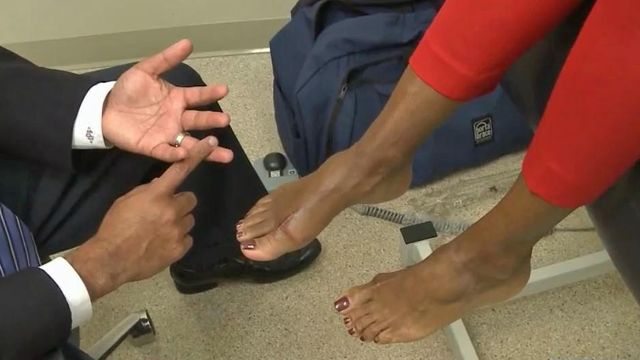New 'toe implant' helps injured athletes stay active
A new toe cartilage implant is offering patients with osteoarthritis a chance to stay active longer.
Posted — UpdatedOsteoarthritis is a major cause of disability that can sometimes cause joints in the knees, hips and toes to fail. The disease makes it difficult for people like Nicky Perry to maintain their active lifestyles.
Perry, 49, is the director of the law library at North Carolina Central University, and she has always loved to exercise. "I bike, I run and I hike," she said. "I'm on my feet a lot."
Nine years ago, Perry was diagnosed with osteoarthritis. Dr. Selene Parekh, an orthopedic surgeon at Duke, performed minor surgery to clean out the joint of the big toe in her left foot.
Perry thought she was in the clear, but, in September, an x-ray of the same joint in her right foot revealed a bigger problem.
"Nicky started experiencing bone spurring, and she was also starting to lose the joint space," said Dr. Parekh. "In the past, our only option was to fuse or lock the two bones together, which causes patients to lose all motion in the affected toe."
Luckily, a new implant option for these patients became available in the United States in May, just months before Perry's problem emerged. It's called the Cartiva Synthetic Cartilage Implant, and it replaces worn down cartilage in the joint of the toe.
The operation is considered an outpatient procedure. To place the implant, surgeons make an incision above the toe joint and move muscle and tendon to the side. A special drill creates a pocket in the tip of the bone, and another tool places the synthetic implant.
"That synthetic plus is made out of the same material as contact lenses," said Dr. Parekh. "That acts as a cushion, so that the other bone is bumping on the bumper rather than rubbing on the bone itself."
After receiving the operation, Perry was back on her feet the same day. There is still some swelling in her toe, and she'll have to wear a special protective shoe for four weeks, but Perry is back to the active lifestyle she loves.
"I'm back to exercising four days a week in the gym," she said.
Perry is also looking forward to being able to wear her favorite shoes again. "I'm a bit of a shoe hog," she said. "I love having the ability to still wear heels."
• Credits
Copyright 2024 by Capitol Broadcasting Company. All rights reserved. This material may not be published, broadcast, rewritten or redistributed.




